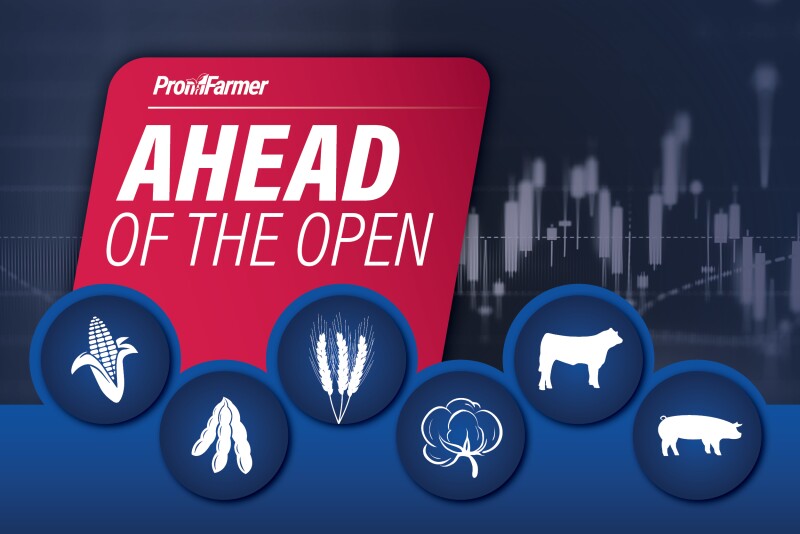GRAIN CALLS
Corn: Steady to 2 cents lower.
Soybeans: 2 to 4 cents lower.
Wheat: Steady to 2 cents lower.
GENERAL COMMENTS: Corn, soybeans and wheat each saw modest losses in the overnight session. Corn and soybeans continue to trend largely sideways ahead of today’s USDA reports. Outside markets are mixed this morning as front-month crude oil futures are facing followthrough selling while the U.S. dollar index is around 90 points lower.
History shows the agency can make surprising and markets-moving adjustments to its grain stocks forecasts. A Reuters survey of grain analysts shows the average estimate for September 1 U.S. corn stocks, at 1.337 billion bushels, which would be a four-year low and down 24% from a year earlier. However, the analysts’ collective estimate is above the 1.325 billion bushels USDA projected for 2024/25 corn ending stocks in its September 12 monthly supply and demand report. Today’s report is expected to show U.S. soybean stocks of 323 million bushels, according to the Reuters survey. That would be down 5.6% from the prior year and below the 330 million bushels USDA projected for 2024/25 soybean ending stocks in its September 12 report. For U.S. wheat stocks, the survey shows the average estimate of 2.043 billion bushels would be up 2.6% from 1.992 billion bushels a year ago and would represent the largest September 1 wheat stocks figure since 2020. USDA’s final estimate for the 2024-25 U.S. wheat crop production is set for release, too.
USDA rated the corn crop as 66% “good” to “excellent” and 10% “poor” to “very poor,” both unchanged from a week ago. The soybean crop is rated 62% “good” to “excellent” (up one point) and 11% “poor” to “very poor” (down a point). On the weighted Pro Farmer Crop Condition Index (CCI; 0 to 500-point scale, with 500 representing perfect), the corn crop declined 0.4 points to 369.9. The soybean crop increased 1.3 points to 359.1. Although soybeans bucked the normal trend of condition declines late in the growing season, they are still below the rating at this time last year. The small change in conditions likely did not have a large impact on yields, as the report also indicated 79% of bean acres are mature and beginning to drop leaves.
Pro Farmer crop consultant Michael Cordonnier said in his weekly report that early U.S. corn yields “are generally disappointing, which could be an indication that southern rust has caused more problems than originally anticipated.” The disease moved into the Midwest in July when hot and humid conditions were favorable for rust development. “The disease probably caught a lot of people by surprise and even farmers who sprayed for the disease are reporting disappointing yields.” Cordonnier’s U.S. corn yield was left unchanged this week at 182.0 bu/ac, with a neutral to lower bias. “I was leaning toward lowering the corn yield this week but decided to wait for more corn yields to be reported.” Cordonnier also left his U.S. soybean yield unchanged this week at 52.0 bu/ac, with a neutral to lower bias. “For the soybean crop, the drier conditions in the eastern and southern locations are a concern, especially now with warmer temperatures. These conditions should force the soybeans to mature quickly and could result in smaller and lighter seeds than originally anticipated.”
CORN: December corn are back at 40-day moving average support, currently at $4.19 1/2. A close below that level today would indicate a technical breakdown. Resistance stands at $4.22 1/2 then $4.25 on a push higher.
SOYBEANS: November soybeans continue to trade in a tight trading range. Bulls are eyeing resistance at $10.17, while support comes in at $10.00 on a push lower.
WHEAT: December SRW wheat continues to see persistent selling pressure. Bulls are looking to tackle $5.20 then $5.25 resistance on report driven strength, while support stands at $5.10 on continued selling pressure.
LIVESTOCK CALLS
CATTLE: Choppy/higher.
HOGS: Choppy/lower.
CATTLE: Cattle futures are expected to open with a mostly firmer tone as technical support continues to bolster prices, though waning cash fundamentals could limit gains after the open. Last week’s cash cattle average was down $4.86 to $232.65, the steepest decline since cash trade turned lower a month ago. Wholesale beef ended Monday lower, with Choice slipping 75 cents to $370.68 while Select sunk $3.55 to $348.89.
HOGS: Lean hog futures are expected to open with a mostly weaker tone in a continuation of yesterday’s selling pressure. Nearby futures saw profit-taking on Monday as prices remain just below contract highs. Continued relative strength in cash fundamentals could limit losses after the open. The CME lean hog index is down a nickel to $104.78 as of Sept. 26. Pork cutout slid $1.30 to $112.22 Monday, led by losses in bellies.

